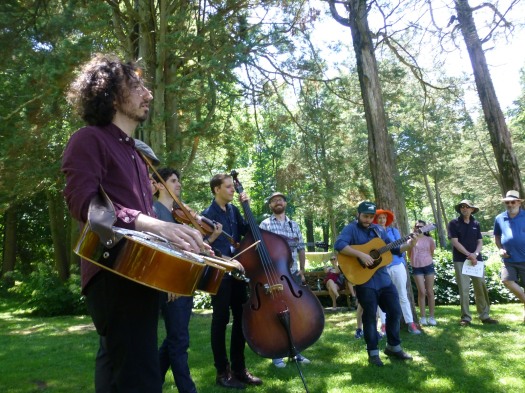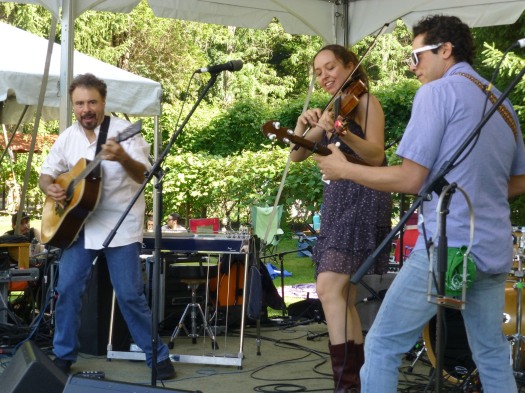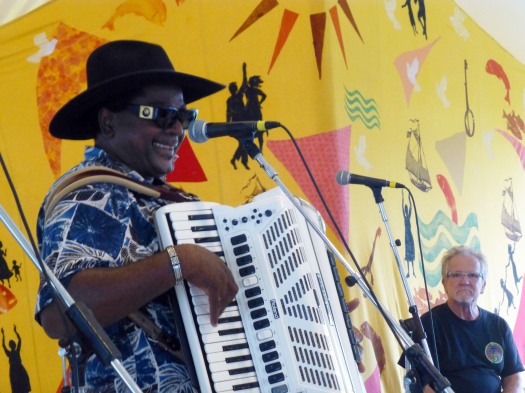I’ve seen the Carolina Chocolate Drops four times, and Rhiannon Giddens under her own name three. You could say I’m a fan, of both the group and of Rhiannon as a solo act. Her show at New York’s Caramoor this year, ending a near-perfect day of outdoor shows and jams as part of the American Roots Music Festival, was an ideal balancing act.

Giddens (above) isn’t a cult favorite anymore; she’s gone mainstream. A capacity audience jammed the Venetian Theater, and gave her standing ovations before she was even halfway through. The turning point was a luminous public performance of Odetta’s song “Waterboy,” and her 2015 album Tomorrow is My Turn, produced by T-Bone Burnett. It’s a fine album, but by showcasing her (stellar) vocals, it presents an incomplete picture of what Giddens can do.

Giddens was on fire, and she covered all her bases. (Jim Motavalli photo)
A show I saw in Brooklyn promoted the Tomorrow album, and as such left me somewhat frustrated—she hardly touched her banjo or fiddle, though she’s a virtuoso on both. The situation reminded me of the experience of the brilliant Nat King Cole, whose skills as a pianist were pushed in the background after that magnificent foghorn of a voice hit the pop charts—and stayed there. Cole even made an album as a singer with George Shearing at the keys—a shame.
But solo Giddens is stretching her huge wings, and the Caramoor show was unreservedly great, with the full range of her talents on display. She’s already on her way to becoming a major star, and she couldn’t be more deserving of it. Between the opening “Spanish Mary” (taken from Lost on the River/Basement Tapes album of unrecorded Bob Dylan) to Aretha Franklin’s “Do Right Woman” encore, she was simply on fire.
Highlights included a furious fiddle duet with ace collaborator and multi-instrumentalist Dirk Powell, who keeps the traditional fires burning; a string of great original songs centered on the African-American experience of slavery (taken from this year’s Freedom Highway, co-produced by Powell); an intense give and take with Chocolate Drop Hubby Jenkins on the spiritual “Go Where I Send Thee”; a master vocal class with Patsy Cline’s “She’s Got You” and even a Cajun interlude.

Cole Quest (left) is walking in Grandpa Guthrie’s footsteps. (Jim Motavalli photo)
There was so much music at the American Roots Music Festival it’s hard to do justice to all of it. Spuyten Duyvil, favorite sons (and daughter) here, were their usual boisterous selves (and lead the Grateful Dead-song social hour later). Cole Quest is Woody Guthrie’s grandson, and Arlo’s nephew. His band the City Pickers was a mainstay of the event, mixing it up with nearly everyone there. Quest plays dobro and does justice to Grandpa’s songs.

Kaia Kater (right) was a bit subdued, but well worth seeing. (Jim Motavalli photo)
I loved banjo player Kaia Kater’s album Nine Pin, released last year. In performance with a bass player, she was a bit subdued, but still compelling. She later turned up with Giddens, and the two of them make a convincing case that African-American folk music is back, and that women are in the vanguard.
I missed Eddie Barbash’s set, but heard him blow sax in one of the jams, and was amazed that an alto sax can be turned into a credible bluegrass solo instrument. Barbash was a member of Stephen Colbert’s band, and played with Chico Hamilton, Yo Yo Ma, Lenny Kravitz and Parliament. But now he’s leading an eponymous band and “playing American Roots music on alto sax.”

The Mammals are Mike + Ruthy with their old name back. Don’t miss their Summer Hoot in August. (Jim Motavalli photo)
Michaela Anne has a great singing voice, a fine band, but no songs that really stuck at Caramoor. I enjoyed River Whyless more simply because they were so unexpected. They looked like a roots band, but made virtually none of the genre’s clichéd moves—the roots were sprayed with day-glo paint. There were elements of jazz, psychedelic rock, and more. The experimental edge helped them stand out during a crowded day.

Michaela Anne (left) had everything but a tackle box for the hooks. (Jim Motavalli photo)
The Lonely Heartstring Band, which started out covering a seminal Beatles album that turns 50 this year, was less adventurous, though I loved what they did to “Graceland.” Who knew that made a good bluegrass song?
I’ve written much about the Mammals (formerly Mike + Ruthy) that I don’t have to reiterate it here. If you have a chance to see this husband-and-wife act, do. Like Rhiannon Giddens, they have it all–dynamic performances, stellar singing (solo or in harmony), and both instrumental and songwriting skills in abundance. Their native habitat is the Summer Hoot in Ashokan, New York.
I caught five minutes of Jefferson Hamer (who made a great album of trad ballads with Anais Mitchell), and he was especially fine on “Old Churchyard”) recently covered by The Decembrists with Olivia Chaney).

The Brother Brothers are Adam (left) and David Moss. You’re going to hear more from these identical twins. (Jim Motavalli photo)
I’m an identical twin, so probably predisposed to love a twin act, but I’d heartily endorse The Brother Brothers if the two were entirely unrelated.
Adam Moss (who also worked with Anais Mitchell) excels on fiddle, is a very strong singer, and haunting songwriter. David Moss has the songs, the singing and killer cello chops.
Together, they’re a modern Everly Brothers in terms of harmonies, so it wasn’t surprising they did two songs from Phil and Don. They’re funny too, and from Peoria. Check out their Tugboats EP.

Sarah Jarosz was fine, if a bit studied and subdued. (Jim Motavalli photo)
The evening concert featured Sarah Jarosz, the enfant terrible of bluegrass who’s mostly grown up now. With Anthony da Costa on colorful guitar washes and the absolutely ace base player Jeff Picker, she was fine, very tasteful, and sang her lovely songs well. But I prefer her records.

Sarah Jarosz (right) with Adam Moss of the Brother Brothers. (Jim Motavalli photo)
Live, Jarosz’ raps were a little too scripted, her instrumental skills were muted in favor of the singing (which won her Grammys), and she could have used a little of Rhiannon Giddens’ fire. But, then, you could say that about almost any performer in the world.








